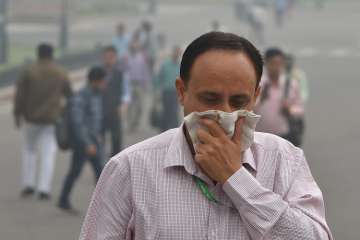The national capital and the surrounding areas witnessed ‘severe’ pollution level as the air quality further deteriorated on Tuesday with no improvement due to weather conditions over the next few days. The Air Quality Index (AQI) of Delhi was 409 at 4 PM, or severe against 399 at the same time on Monday. The air quality of Gurugram on Tuesday dropped to "very-poor" on Monday.
Parts of Delhi saw traces of train on Tuesday, which however was insufficient to settle the pollutants, experts said.
Weather conditions are likely to remain the same till Friday, said weather analysts.
"The conditions will remain the same till November 16 after which Delhi would receive dry and cold north-westerly winds which would disperse the pollutants," said Mahesh Palawat, director private weather agency Group Skymet.
The major pollutant PM2.5 or particles with diameter less than 2.5mm, were well above severe levels across Delhi-NCR.
At 6 p.m., the average aggregation of PM2.5 across 36 stations was 278 microgrammes per cubic meters against 271 units on Monday. The same across 49 areas of NCR was 270 units.
The safe limit for PM2.5 is 60 units as per national standards and 25 units according to the international standards.
The System of Air Quality and Weather Forecasting And Research (SAFAR) updated its warning system on Tuesday and asked people to skip walks. It however, it not ask people to avoid all outdoor physical activities.
A new study meanwhile revealed nearly 89 per cent of people feel sick or discomfort, due to the deteriorating air quality in Delhi and adjoining areas.
The study titled "Perception Study on Air Quality" by the ASAR Social Impact Advisors, which works on social and environmental issues, said the awareness level was higher in the metros with the Delhi and National Capital Region (NCR) respondents showing the maximum awareness of all three terms -- Air Quality Index, Particulate Matter 2.5 and Particulate Matter 10.
The study covers cities with a highly-polluted air -- Delhi-NCR, Kolkata, Patna, Lucknow, Varanasi, Amritsar, Singrauli, Dhanbad, Raipur, Korba, Chandrapur, Angul, Nagpur and cities becoming rapidly polluted -- Bengaluru, Pune, Mumbai and Chennai.
The top two sources of AQI information for those who were aware and who understood AQI were newspapers and mobile apps, the study said.
Motor vehicles, industrial units, deforestation and industrial activities were pointed out to be major factors contributing in the rising level of pollutants in the air.
On Tuesday, the AQI was 438 at Faridabad and Ghaziabad, 411 in Greater Noida and 426 in Noida, all falling under severe category.
Latest India News
